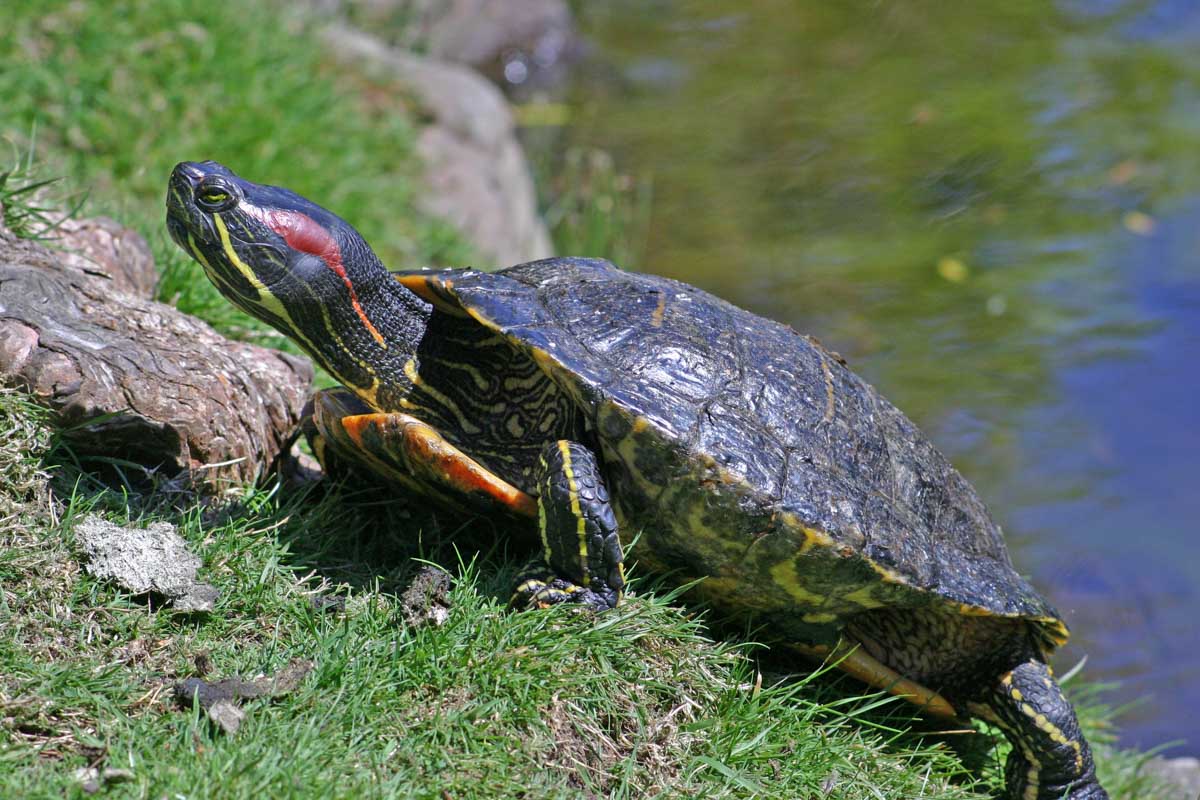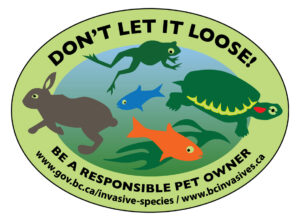FOUND IN B.C.? Yes. They are found in the Lower Mainland, the Gulf Islands, Vancouver Island and parts of the Southern Interior. There have not yet been any Red-eared sliders detected in the Columbia Shuswap Regional District.
Identification
Their shells are smooth and typically dark olive-green to black in colour and the plastron (shell underside) is yellow. Yellow lines mark their heads, neck and limbs. The most distinctive characteristic of the Red-eared slider, as their name suggests, is the red patch behind their ear.

The Western painted turtle is found in similar freshwater habitats. It is the only native freshwater turtle surviving in B.C. and it has a range limited to the southern part of the province. The Intermountain-Rocky Mountain population, which is generally found in the Kootenay, Columbia, Thompson and Okanagan river valleys, is listed as special concern by the Committee on the Status of Endangered Wildlife in Canada (COSEWIC). The carapace of the Western painted turtle is smooth and flatter than that of the Red-eared slider and its plastron is more red-orange in colour.

Lifecycle
Red-eared sliders can live up to 30 years in the wild, and even longer in captivity! Females can begin laying eggs as young as 2 years old and they can lay up to 70 eggs per year. Like other turtles, Red-eared sliders lay their eggs in the ground and it will take between 55-80 days for eggs to hatch (the cooler the temperature, the longer the incubation period). Also, once fertilized, eggs can remain viable inside the female for up to 5 years! These high fecundity rates is what allows Red-eared sliders to have such a competitive advantage over native turtle species.
Ecology
They are a medium-sized freshwater turtle and they prefer areas with warm and slow-moving water like ponds, lakes, swamps and sometimes smaller streams and rivers. As a semi-aquatic animal, they lay their eggs on land but the adults spend most of their life in and around water. Here, they prefer to eat aquatic plants but they will also feed on small fish, tadpoles, worms and insects found in the water. And like other turtles, they are ectotherms, which means that they use external sources (like the sun) to regulate their body temperature, so you can often find them basking on logs or rocks in their ponds and lakes.
Introduction and Spread
The Red-eared slider is native to warm climates in the southern U.S. and northern Mexico. In B.C., the Red-eared slider can be found in the Gulf Islands, Burnaby Lake and around the Greater Vancouver area.
Due to their popularity as pets, their primary mode of introduction to new regions is through pet and aquarium releases. Red-eared sliders can live up to 30 years in the wild, so they likely can live longer with good care in captivity and without the pressure of predation. Thirty years is a long time to be caring for a pet! And so, pet owners often have a change of heart and no longer wish to care for their pet turtle and release the turtle in a nearby park or pond.
Impacts
The Red-eared slider is the most commonly traded turtle in the world and one of the most popular turtles as pets. Due to this popularity, many Red-eared sliders have been released or escaped into the wild. This has led them to land on the list of “100 of the World’s Worst Invasive Alien Species” by the IUCN, the International Union for the Conservation of Nature – a list also highlighting species like zebra mussels, the Nile perch and water hyacinth. In fact, their trade and possession has been banned in some parts of the world, like Europe and Australia.
Red-eared sliders have characteristics that help them survive and become invasive in new habitats. Compared to our native turtles, they have larger bodies, which is advantageous in winning over feeding, nesting and basking sites. They mature at a younger age and have higher fecundity rates, so they have more surviving offspring and their populations can grow faster than native turtles. And Red-eared sliders transmit diseases to native turtles, which puts even more pressure on already at-risk species, like the Western painted turtle.
What Can We Do?
DON’T LET IT LOOSE: As humans, we are the number one vector of spread for invasive species but we can also play an important role in stopping new invasions and infestations. Making slight changes to some of our behaviours is key to preventing and managing the spread of invasive species. The most important step you can take to prevent the spread of Red-eared sliders is to be a responsible pet owner. This means that we understand and accept the responsibility of owning a pet and Don’t Let It Loose to the wild when the pet is longer wanted or can no longer be cared for. Most pets actually don’t survive in the wild as they do not have the proper adaptations to find food sources or detect predators. So before purchasing or adopting any pet, consider how you will take care of it for its entire lifespan. If you are longer able to care for a pet, contact rescue centres or other resources in your community to attempt to re-home your pet. Euthanization of the pet will be the last resort approach to dealing with a pet that can no longer be cared for, which is why it is really important to understand the long-term needs of the pet before ownership. This practice also applies to plants that we may have in our terrariums, aquariums or ponds as well.
REPORT: Report all sightings of invasive species to CSISS on our website, to the Province with their online form or on the ReportInvasive mobile app.
Literature and Resources